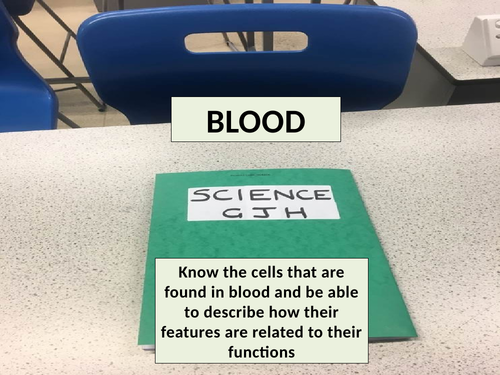The BLOOD
Subject: Biology
Age range: 11-14
Resource type: Worksheet/Activity




A resourced lesson which looks at three of the main components of blood and ensures that students can relate their features to their function. The lesson includes an engaging lesson presentation (31 slides) and an associated worksheet
The lesson begins by challenging the students to recognise blood from a description of some of its contents. This will enable students to identify some of the substances like hormones and urea that are carried in the plasma. Moving forwards, the rest of the lesson takes a format where the students have to act as recruitment consultants. They have been given 3 job roles to fill and once they have decided on the right candidates for the job, they need to be able to explain why these have been chosen. Students will go study the red and white blood cells and platelets, focusing on how their different specialised features enable them to effectively carry out their respective functions. Students will be able to compare the cells in terms of size, number of nuclei and ultimately explain why they have their features.
There are regular progress checks throughout the lesson to allow the students to check on their understanding. This lesson has been designed for GCSE students but is perfectly suitable to be used with KS3 students who are studying the circulatory system
A bundle is a package of resources grouped together to teach a particular topic, or a series of lessons, in one place.
This bundle of 13 lessons covers the majority of the content in Topic B2 (Scaling Up) of the OCR Gateway A GCSE Combined Science & GCSE Biology specifications. The topics covered within these lessons include: Mitosis Cell differentiation Cell specialisation Stem cells Diffusion Osmosis Active transport Exchange surfaces The heart in the circulatory system The blood and blood vessels Plant transport systems Transpiration All of these lesson presentations and accompanying resources are detailed and engaging and contain regular progress checks to allow the students to constantly assess their understanding.
This bundle of 7 lessons covers the majority of the content in the sub-topic B2.2(The challenges of size) of the OCR Gateway A GCSE Combined Science specification. The topics covered within these lessons include: * Explain the need for exchange surfaces and a transport system in a multicellular organism due to the low SA:V ratio * The exchange of oxygen and carbon dioxide with the blood at the alveoli * Explain how the structure of the heart and the blood vessels are adapted to their function * Explain how the red blood cells and plasma are adapted to their transport function in the blood * Describe the processes of transpiration and translocation * Explain how the structure of the xylem and phloem are adapted to their functions in the plant * Explain the effects of a variety of factors on the rate of water uptake * Describe how a simple potometer can be used to investigate the rate of water uptake All of these lesson presentations and accompanying resources are detailed and engaging and contain regular progress checks to allow the students to constantly assess their understanding.
This bundle of 6lessons covers the majority of the content in Topic B7 (Transport) of the core and supplement sections of the Cambridge iGCSE Science Double Award specification. The topics and specification points covered within these lessons include: The functions of the xylem and phloem The transport of water through the xylem vessels Transpiration as the loss of water vapour Factors affecting transpiration rate Name and identify the structures of the mammalian heart The transport of blood in arteries and veins The blood vessels associated with the heart and lungs Coronary heart disease The structure and function of arteries, veins and capillaries The function of red and white blood cells, platelets and plasma All of these lesson presentations and accompanying resources are detailed and engaging and contain regular progress checks to allow the students to constantly assess their understanding
This bundle of 8 lessons covers the majority of the content in Topic B2 (Organisation) of the AQA Trilogy GCSE Combined Science specification. The topics covered within these lessons include: Enzymes Enzyme reactions The Heart The Blood vessels The Blood Cardiovascular disease Health and disease Risk factors for non-communicable diseases Transport in plants through the xylem and phloem Transpiration (and stomata) All of these lesson presentations and accompanying resources are detailed and engaging and contain regular progress checks to allow the students to constantly assess their understanding.
This bundle of 7 lessons covers the majority of the content in Topic B8 (Exchange and transport in animals) of the Edexcel GCSE Combined Science specification. The topics covered within these lessons include: The need to transport substances Surface to volume ratio Gas exchange at the alveoli The structure of blood and its function The structure of blood vessels The structure of the heart Aerobic and anaerobic respiration All of these lesson presentations and accompanying resources are detailed and engaging and contain regular progress checks to allow the students to constantly assess their understanding.
Something went wrong, please try again later.
This resource hasn't been reviewed yet
To ensure quality for our reviews, only customers who have purchased this resource can review it
Report this resourceto let us know if it violates our terms and conditions.
Our customer service team will review your report and will be in touch.